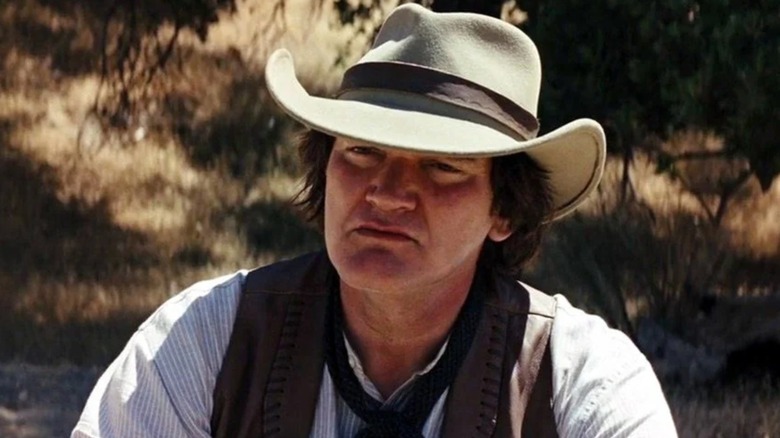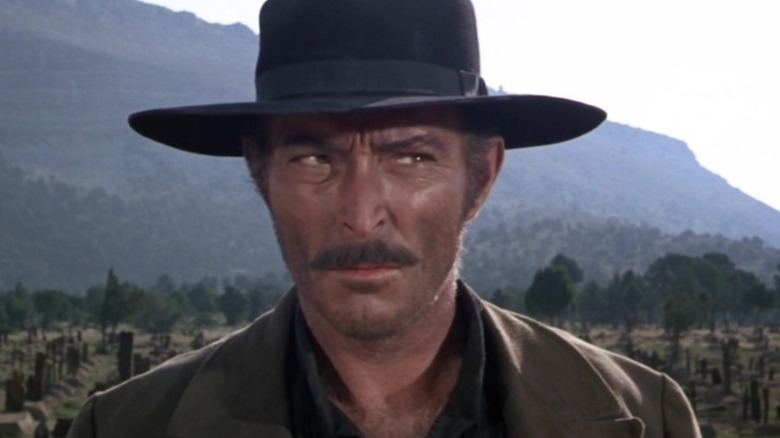Quentin Tarantino Wishes He Could Have Made A Movie With This Western Actor
We may receive a commission on purchases made from links.
As part of Quentin Tarantino's love of B-entertainment (and his career spent making pastiches of it), he often recruits actors who worked in lowbrow movies or TV he loved. "Pulp Fiction," "Jackie Brown," and "Kill Bill" were all made to varying degrees as career CPR for John Travolta, Pam Grier, and David Carradine, respectively. Tarantino also had Franco Nero, the original Django, cameo in "Django Unchained." There's one mid-20th century Western star he regrets not getting to work with, though.
In 2014, Tarantino appeared on "The Director's Chair," a talk show hosted by his friend and sometimes collaborator, Robert Rodriguez. During their conversation, Rodriguez asked Tarantino: "Who, in your opinion, is the ultimate badass actor of all time?"
"There's a lot of guys you can say," Tarantino answered, but the one he chose was Lee Van Cleef (apparently he'd "been on a real Lee Van Cleef kick" at the time). Van Cleef was most known for appearing in Westerns as "black hats," or the bad guys. Sadly, he died in 1989, a few years before Tarantino started directing movies with 1992's "Reservoir Dogs."
"I really wish I could've worked with Lee Van Cleef in that '69-'70 time period," Tarantino continued. During the 1950s and '60s, Van Cleef had small roles in Hollywood, black-and-white Westerns. His first film appearance was as a gang member in 1952 Gary Cooper Western, "High Noon." In 1962, he appeared as another black hat in John Ford's "The Man Who Shot Liberty Valance."
The movies that most remember Lee Van Cleef for, though, are Spaghetti Westerns directed by Sergio Leone. He appeared in two Leone movies alongside Clint Eastwood: "For A Few Dollars More" and then "The Good, The Bad, and the Ugly."
Contrary to his usual reputation, Van Cleef played a hero in "For A Few Dollars More." His character is bounty hunter Douglas Mortimer, who is pursuing a bandit gang to avenge his sister's murder. He then more than balanced that out with Angel Eyes from "The Good, The Bad, and the Ugly" (he's "The Bad"). There's an archetypal gunslinging Western villain in pop cultural memory — a greedy, unscrupulous gunslinger dressed in dark clothes, who is just as cool as the cowboy hero but without any heart of gold within. For most people, that archetype's name is Angel Eyes.
Quentin Tarantino never got to make a Lee Van Cleef picture
"If anyone was doing a movie, and they needed a bad guy, someone who was really despicable, they'd say, 'Go out and get Lee Van Cleef,'" said Johnny Carson when Van Cleef appeared on his show in 1984. "You've probably played more villains than any other person in motion pictures."
Oftentimes, actors can be typecast based on what they look like. With Lee Van Cleef's face, he was born to play bad guys. He had a sharp nose and cheekbones, plus curved eyebrows resting over his gaze that could look right through your soul. He had the features of a hawk mixed with the coiled menace of a snake; throw in the moustache he wore as Angel Eyes and you've got the whole heavy package.
As Van Cleef told Johnny Carson, though, he never got tired of playing the bad guys. "They've got a lot of depth, some of them, if you can get some sympathy mixed with the horrible things," he said, explaining the challenge that comes to any actor playing the villain.
Many later villains have been crafted in Van Cleef's image. Bounty hunter Cad Bane from "Star Wars: The Clone Wars" is a dead ringer for Angel Eyes (just with alien blue skin and red eyes). Rattlesnake Jake from Western homage (with talking animals) "Rango" wears a black bolero hat just like Van Cleef wore in many Westerns. Look at Jake and you'll see just how snakelike Van Cleef's gaze was.
While Tarantino never got to work with Van Cleef, another of his young fans turned filmmaker did. John Carpenter, who has a special fondness for Hollywood Westerns, cast Van Cleef in his 1981 action movie "Escape From New York." The movie is set in a dystopia where all of New York City has become an open air prison. Van Cleef plays Police Commissioner Bob Hauk, who recruits prisoner Snake Plissken (Kurt Russell) to rescue the President (Donald Pleasence) after his plane crashes in New York.
Russell played Plissken with an Eastwood impression, so it only made sense to cast Eastwood's most famous onscreen adversary in the movie too. While Carpenter got to make his Lee Van Cleef picture, it's a shame that we, and Tarantino, can only imagine what Tarantino could've done with pictures' most prolific bad guy.

